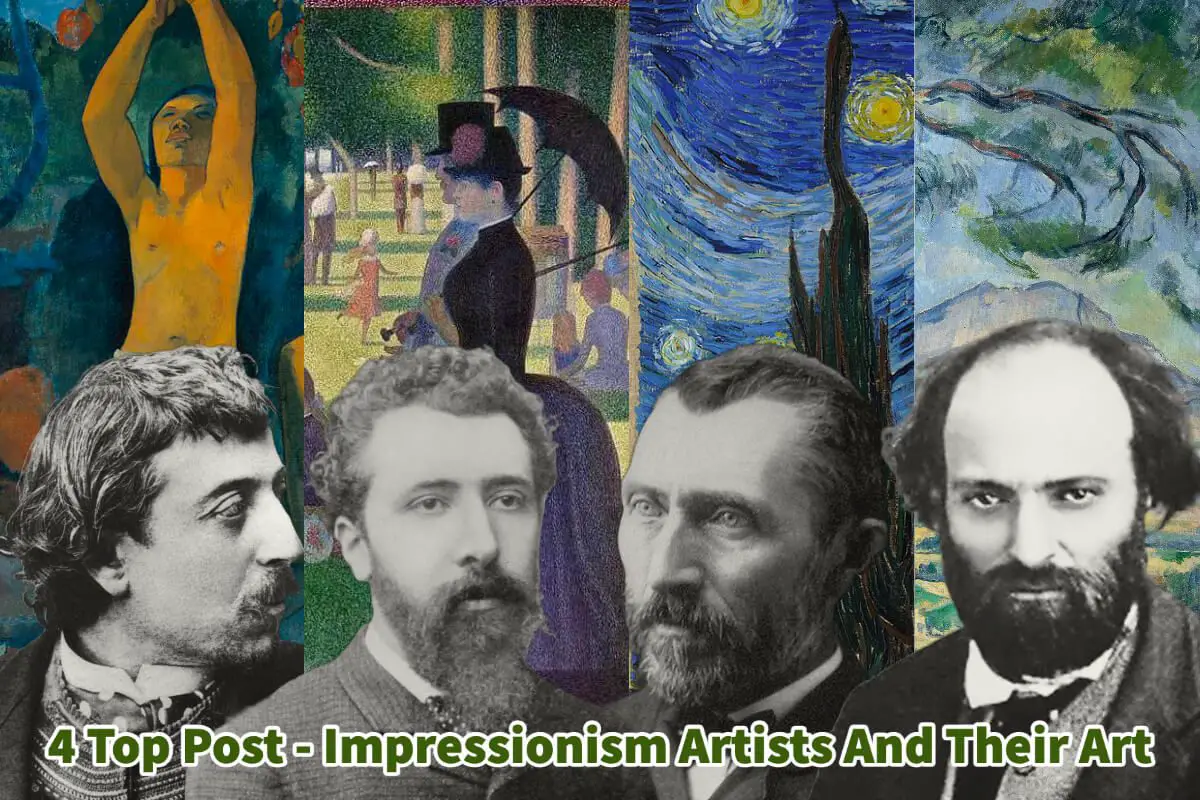Post-Impressionism is a captivating art movement that emerged in the late 19th century as a response to the limitations of Impressionism. Many of my favorite artists are Post-Impressionism artists.
While Impressionists focused on capturing the fleeting effects of light and atmosphere, Post-Impressionists sought to delve deeper into personal expression, exploring new techniques, colors, and subject matter. Read on as we explore the lives and significant works of four top Post-Impressionism artists: Paul Gauguin, Georges Seurat, Vincent van Gogh, and Paul Cézanne.
Table of Contents
- Exploring The Masters Of Post-Impressionism: Gauguin, Seurat, Van Gogh, And Cézanne
- Post-Impressionism Characteristics And Distinctions Explored
- Watch Our Short Stories About 4 Top Post-Impressionism Artists Below!
- Frequently Asked Questions
- Related Questions
Exploring The Masters Of Post-Impressionism: Gauguin, Seurat, Van Gogh, And Cézanne
The Post-Impressionism movement emerged in the late 19th century as a response to the limitations of Impressionism. Four prominent artists who shaped and defined this movement were Paul Gauguin, Georges Seurat, Vincent van Gogh, and Paul Cézanne.
Read as will delve into the lives, notable artworks, and distinct contributions made by these artists.
Paul Gauguin (1848-1903)
Paul Gauguin, a French Post-Impressionist artist, was born in Paris, France, on June 7, 1848. Gauguin initially worked as a successful stockbroker but eventually abandoned his conventional lifestyle to pursue his passion for art.

He developed a unique artistic style characterized by bold colors, simplified forms, and a symbolic approach to storytelling.
One of Gauguin’s most famous Post-Impressionist works is “Where Do We Come From? What Are We? Where Are We Going?” (1897-1898). This large-scale painting reflects Gauguin’s introspective exploration of human existence, spirituality, and the search for meaning.
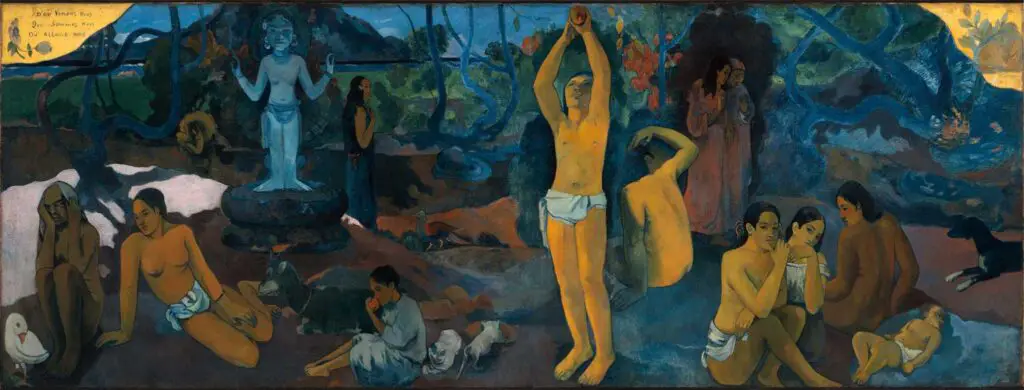
This piece’s vibrant colors and flat forms demonstrate his departure from traditional representational art.
Georges Seurat (1859-1891)
Georges Seurat, a French painter and pioneer of Pointillism, was born on December 2, 1859, in Paris, France. Pointillism was Seurat’s revolutionary technique involved using small, distinct dots of pure color that, when viewed from a distance, blended to create an overall optical effect.

His most celebrated Post-Impressionist work is “A Sunday on La Grande Jatte” (1884-1886). This monumental painting showcases Seurat’s meticulous pointillist technique and depicts people leisurely strolling along the banks of the Seine River.
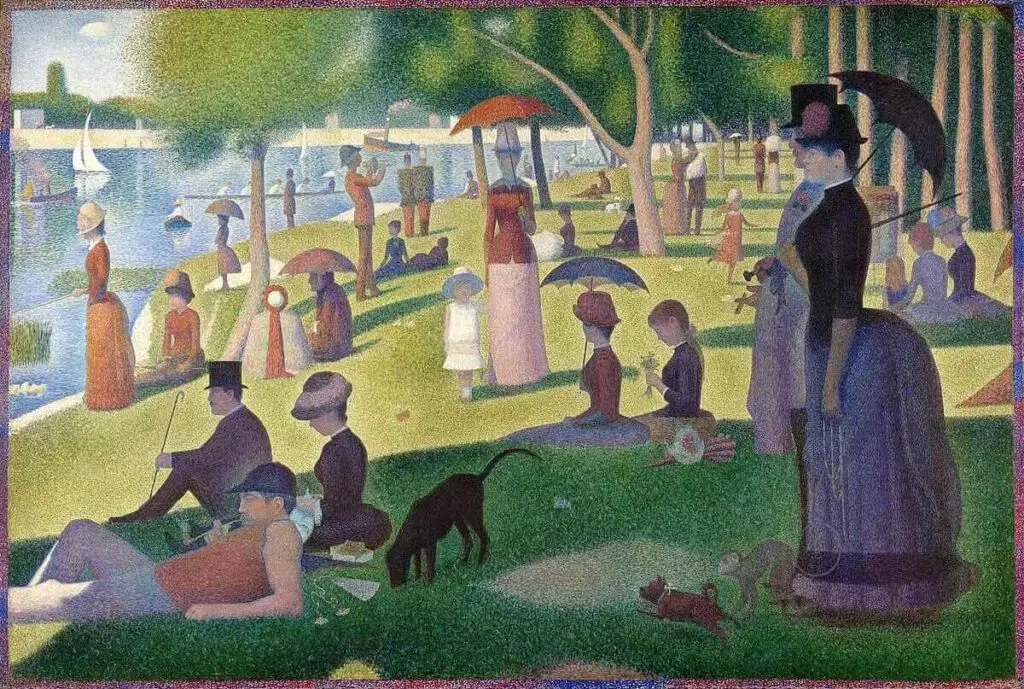
By capturing light, color, and movement through thousands of individual dots, Seurat created a groundbreaking style that laid the foundation for modern art.
Vincent van Gogh (1853-1890)
Vincent van Gogh, a Dutch Post-Impressionist artist, was born on March 30, 1853, in Groot-Zundert, Netherlands. Van Gogh’s artistic journey was fraught with emotional turmoil and personal struggles, but his passionate and expressive style left an indelible mark on the art world.
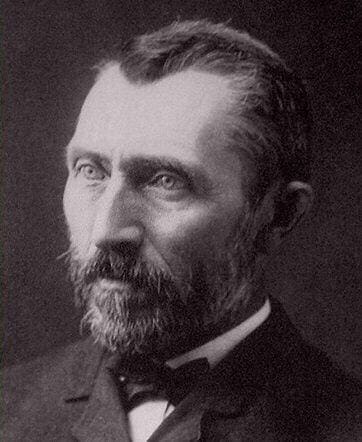
Van Gogh’s iconic masterpiece, “Starry Night” (1889), is a testament to his innovative use of color and expressive brushwork. This night landscape portrays a swirling sky, vibrant stars, and a sleeping village beneath.
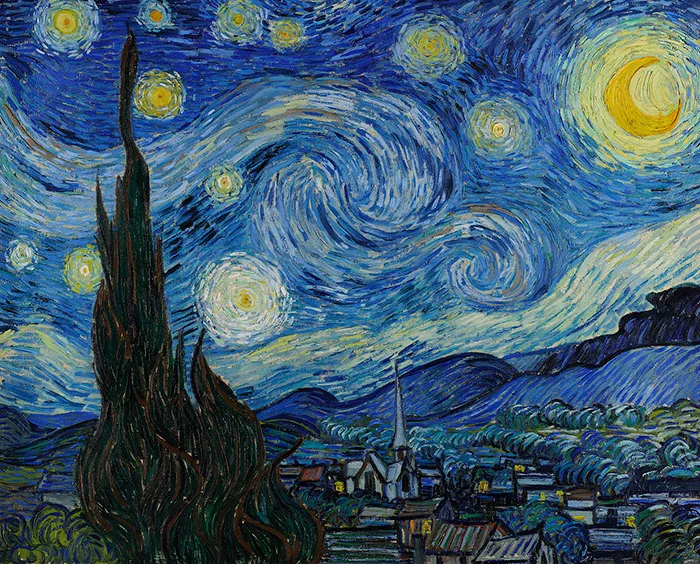
Van Gogh’s thick application of paint and visible brushstrokes emphasize his emotional response to the scene, inviting viewers into his turbulent inner world.
Paul Cézanne (1839-1906)
Paul Cézanne, a French artist often considered the bridge between Impressionism and Cubism, was born on January 19, 1839, in Aix-en-Provence, France. Cézanne’s unique style focused on geometric forms and explored multiple perspectives, foreshadowing the revolutionary developments in 20th-century art.

One of Cézanne’s most significant Post-Impressionist works is “Mont Sainte-Victoire” (1885-1887). This landscape painting depicts the mountain overlooking his hometown, capturing the essence of nature through simplified forms and distinctive brushwork.

Cézanne’s relentless pursuit of structure and composition had a profound impact on the development of modern art.
Post-Impressionism Characteristics And Distinctions Explored
Post-Impressionism is a significant movement in the history of art that emerged in the late 19th century, building upon the foundations laid by Impressionism. While Impressionism aimed to capture the fleeting moments of light and atmosphere, Post-Impressionism took a step further, exploring new artistic possibilities and pushing the boundaries of representation.
We will explore some of the most essential characteristics of the Post-Impressionism movement.
Vivid Colors And Post Impressionism Art
Post-Impressionists embraced vibrant and bold colors, moving away from the more subdued palette of Impressionism. Artists like Gauguin and Van Gogh used colors symbolically, evoking emotions and conveying personal experiences.
The intense hues added depth and intensity to their works, capturing the essence of the artist’s vision.
Thick Application Of Paint And Post-Impression Art
Post -Impressionists often applied paint with a heavier, more textured brushstroke, creating a palpable surface quality.
Van Gogh, in particular, used impasto techniques, applying thick layers of paint to give his works a three-dimensional feel. This tactile quality added energy and expression to the artwork.
Distinctive Brush Strokes And Post-Impressionism
Post-Impressionist artists developed individualistic and recognizable brushwork, moving beyond the soft, blended strokes of Impressionism. The brushstrokes became integral to the composition, with each mark contributing to the visual language.
Seurat’s pointillism technique, consisting of tiny dots of color, and Van Gogh’s expressive and swirling strokes are prime examples of this characteristic.
Real-Life Subject Matter And Post-Impressionism
While Impressionists focused primarily on landscapes and scenes of everyday life, Post-Impressionists expanded their subject matter to personal experiences, emotions, and introspection.
Artists like Gauguin and Van Gogh often painted from their inner worlds, infusing their works with symbolism and deeper meaning. Cézanne, on the other hand, explored the structural aspects of nature and still life, breaking down forms into geometric shapes.
Post-Impressionism was a movement aimed to push the boundaries of artistic expression, challenging the conventions of the art world of its time. The artists sought to convey their personal experiences, emotions, and ideas through their works, using color, brushwork, and subject matter as powerful tools.
Post-Impressionism was not a unified or cohesive movement with a single manifesto or principles. Instead, it encompassed diverse artists with unique styles and artistic philosophies.
However, the artists shared a common desire to move beyond the surface impressions of Impressionism, seeking a deeper understanding of the world and themselves.
The four top Post-Impressionist artists, Paul Gauguin, Georges Seurat, Vincent van Gogh, and Paul Cézanne, played pivotal roles in shaping the course of modern art with the Post-Impressionism movement. Their innovative artistic techniques, bold use of color, distinctive brushwork, and exploration of real-life subject matter transformed the art world and laid the groundwork for future artistic movements.
Post-Impressionism provided a platform for artists to express their inner emotions, challenge traditional artistic norms, and experiment with new approaches to painting. Through their groundbreaking works, Gauguin, Seurat, Van Gogh, and Cézanne left an enduring legacy, inspiring generations of artists to come.
The impact of Post-Impressionism can still be felt today, as its influence extends far beyond the late 19th and early 20th centuries. The movement’s emphasis on personal expression, innovative techniques, and exploration of color and form opened the doors to new possibilities in art and set the stage for the revolutionary developments of modern and contemporary art.
Watch Our Short Stories About 4 Top Post-Impressionism Artists Below!
Anita Louise Art is dedicated to art education, great artists, and inspiring others to find and create their art. We love art that uplifts and inspires. #ArtToMakeYouSmile! #ArtToMakeYouHappy!
If you are interested to see any of my art, you can find out more by clicking here. If you are interested in what inspires me and my paintings, you can discover more by clicking here.
We have a free newsletter and would love you to be part of our community; you can subscribe to the newsletter by clicking here. If you have any questions, I would be happy to talk to you anytime. You can reach me, Anita, by clicking here.
Subscribe to our Anita Louise Art YouTube Channel with great videos and information by clicking here.
Join us for our podcast “5 Minutes With Art.” Spend just 5 minutes a week with us to discover and learn about great art and artists. You can find out more about our podcast by clicking here.
Frequently Asked Questions
Who were the key artists associated with the Post-Impressionism movement?
Post-Impressionism was a diverse movement, but four key artists who made significant contributions were Paul Gauguin, Georges Seurat, Vincent van Gogh, and Paul Cézanne. Each artist had a distinctive style and approach to art.
What sets Post-Impressionism apart from Impressionism?
While Impressionists focused on capturing the transient effects of light and atmosphere, Post-Impressionists went beyond and sought to convey personal expression. They explored new techniques, colors, and subject matter, aiming for a deeper emotional and symbolic impact in their artworks.
How did Paul Gauguin contribute to Post-Impressionism?
Paul Gauguin was known for his vibrant use of color and bold experimentation with form. He sought to infuse his art with emotion and symbolism, often drawing inspiration from his experiences in exotic locations like Tahiti. Gauguin’s work laid the groundwork for the Symbolist movement within Post-Impressionism.
What is Georges Seurat’s significance in the Post-Impressionist movement?
Georges Seurat is renowned for developing the Pointillist technique, using small dots of color to create a cohesive image when viewed from a distance. His masterpiece, “A Sunday Afternoon on the Island of La Grande Jatte,” exemplifies this technique and highlights Seurat’s meticulous approach to composition.
How did Vincent van Gogh contribute to Post-Impressionism?
Vincent van Gogh is celebrated for his emotionally charged and expressive paintings. His bold use of color, thick impasto, and swirling brushstrokes characterize his unique style. Van Gogh’s iconic works such as “Starry Night” reflect his intense personal experiences and struggles with mental health.
What role did Paul Cézanne play in the development of Post-Impressionism?
Paul Cézanne is often regarded as a bridge between Impressionism and Cubism. His innovative approach to form and structure, particularly in his explorations of still life and landscapes, influenced later art movements. Cézanne’s emphasis on geometric shapes laid the groundwork for the geometric abstraction seen in Cubist art.
How did Post-Impressionist artists depart from traditional painting techniques?
Post-Impressionists often rejected traditional techniques, opting for unconventional methods to express their ideas. This departure included experimenting with color theory, using innovative brushwork, and exploring non-realistic perspectives, challenging the norms of academic art.
What are the key characteristics of Paul Gauguin’s artistic style?
Paul Gauguin’s artistic style is characterized by bold and vibrant colors, often inspired by his travels to exotic locations. He incorporated symbolic elements into his works, seeking to convey deeper meanings and emotions. Gauguin’s departure from naturalistic color palettes contributed significantly to the evolution of Post-Impressionist art.
How did Pointillism influence Georges Seurat’s artistic vision?
Georges Seurat’s development of Pointillism involved applying small, distinct dots of color to create a unified image. This technique aimed to capture the vibrancy and luminosity of light. Seurat’s meticulous approach to color and composition in Pointillism was a pivotal contribution to the evolution of Post-Impressionist aesthetics.
How did Vincent van Gogh’s mental health impact his artistic expression in Post-Impressionism?
Vincent van Gogh’s struggles with mental health profoundly influenced his artistic expression. His emotional turmoil is evident in the intense colors, bold brushwork, and symbolic elements found in his paintings. Van Gogh’s art serves as a testament to the intimate connection between an artist’s personal experiences and their creative output within the Post-Impressionist movement.
Related Questions
What Was The Focus Of Renaissance Art?
The focus of Renaissance art was on the classics of Greek and Rome, humanist philosophy, and the study of the human figure. Realism was also an essential part of renaissance art. The great artists of the Renaissance also became great anatomists and studied human beings.
By clicking here, you can learn more by reading What Was The Focus Of Renaissance Art?.
What Is The Importance Of Art From The Renaissance Period?
Renaissance art is essential as it was a time of rebirth and discovery. Artists like Leonardo da Vinci, Michelangelo, and Raphael were at the forefront of that change, creation, and discovery. Renaissance art has influenced art and artists for many centuries and continues to influence artists today.
By clicking here, you can learn more by reading What Is The Importance Of Art From The Renaissance Period?.
21 Top Renaissance Artists And Their Works Of Art
When we speak of top Renaissance artists, we think of the trinity of artists like Leonardo da Vinci, Michelangelo, and Raphael. But besides these three artists, many other influential Renaissance artists remain essential.
By clicking here, you can learn more by reading 21 Top Renaissance Artists And Their Works of Art.

